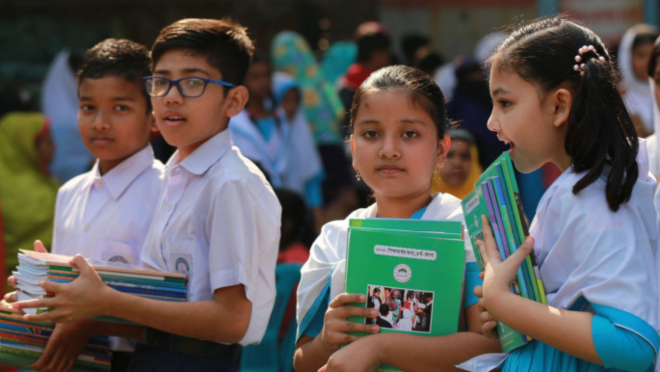World Literacy Day: What we can learn from countries leading the way
World Literacy Day: What we can learn from countries leading the way

8 September marks World Literacy Day and serves as a Global reminder that the ability to read and write is not universal. According to UNESCO (2024), 773 millions of people worldwide still lack basic literacy skills.
But behind every number there’s a life, a future, and often a failure of strategies. This literacy day let’s turn the page on dull speech and examine what really works around the world and what Bangladesh can learn and unlearn on its journey towards true educational empowerment.
Finland: Literacy as a way of living
Finland is consistently ranked among the top performers. Their secret? Reading isn’t taught, it’s lived. Its approach is deceptively simple: trust, minimise, and focus on pleasure for learning.
Formal schooling begins at age 7, but preschool programmers emphasise language-rich play and story based learning. Children grow up surrounded by books, libraries, feel like playgrounds and reading is more fun than function. There’s no pressure on kids to read fluently by a certain age. Instead the environment nudges them organically into literacy. They have free public libraries everywhere.
Here the takeaways for Bangladesh would be, instead of early academic pressure for primary school students, Bangladesh could invest in pre-primary reading programmes, focused on storytelling in both English and Bangla. Also, children should not be subjected to grueling examinations till a certain age to encourage studying for the sake of learning rather than sitting for exams.
Public library access is still extremely low. According to data from the Department of Public Libraries (DoPL), in 2018 there were 71 libraries in the country, which was not at all adequate for a then population of 16 crore. The population of the country has increased to 17.5 in 2025, according to United Nations Population Fund (UNFPA), but an increase in the number of libraries is yet to be recorded.
Japan: Literacy through deep comprehension
Japan’s literacy rate is near 100%. What’s even more impressive is the depth and comprehension and cultural engagement. From a very young age children are exposed to different formats of writing: manga, calligraphy, books, newspapers and encouraged to read critically and discuss.
Reading is not “extra”, it is a central part of science, math and ethics classes.
Takeaways for Bangladesh would be, current textbooks are often rigid and exam oriented. Revising curricula to include functional reading tasks, critical thinking and local cultural content could boost comprehension.
Cuba: National literacy campaign
Cuba launched a bold national literacy drive in 1961, often referred to as the battle of First Grade. Within just one year the literacy rate soared from roughly 60% to around 96%. Over 250,000 volunteers helped teach close to 700,000 adults to read and write.
Through this education became widely accessible, leading to near school enrolment for children within decades.
Bangladesh can draw powerful lessons from Cuba’s 1961 literary campaign, which turned education into a nation-wide movement. Bangladesh can involve youth, local groups to take Literacy beyond schools, focusing not only on reading and writing but also on life skills like digital and financial literacy.
Bangladesh: Progress and present gap
Bangladesh’s literacy rate has climbed from 47% in 2001 to over 75% in 2023, thanks to increased school enrollment, female education incentives, and non-formal education programmes run by NGOs like Brac, Campaign for Popular Education (Campe), and the government’s Primary Education Development Programme (PEDP).
But challenges remain.
According to National Student Assessment (NSA) 2022 of Bangladesh about 50% of grade 5 students demonstrated grade level reading proficiency, slightly up from 44% in 2017. However, the NSA also notes the persistent reading crisis. Almost half of the students in primary grade cannot read in Bangla.
The road ahead: Unlearning bookish literacy
Bangladesh must evolve from literacy as decoding words to literacy as empowerment. Changing the curriculum to something that helps students gain the ability to think, apply knowledge and decide.
Overloaded curriculum: Students are forced to memorise the study materials of 12 to 13 subjects in high-school, leaving little room for thinking and analysing the interests they would like to pursue in future.
Misaligned assessment: Assessment practices rarely match subject needs and its application in future. For example, on ICT exams students are tested on, “how to save a file” in theory, instead of demonstrating computer skills.
These factors create literate students on paper, but not necessarily critical thinkers, problem solvers or decision makers. Bangladesh can adapt global lessons to break out from the cycle of bookish learning.
Reducing the number of compulsory subjects at the middle level, the education system of the country can replace them with deeper, project-based modules and including extracurricular as a part of the compulsory. This would allow students to explore arts, storytelling, and creative literacy without stigma.
Literacy is not just decoding words, it’s the ability to question, create and choose.


